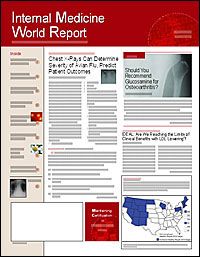Availability of HPV Vaccine Will Lead to New Questions
Acceptability, Accessibility, Implementation Will Dominate Early Agenda
Washington,?DC?A vaccine against human papillomavirus (HPV) infection could be on the market as early as summer 2006. The vaccine is active against HPV types 16 and 18, the HPV types found in >70% of cervical cancers worldwide, and has previously demonstrated 100% efficacy against premalignant disease, said John Schiller, PhD, section chief, Laboratory of Cellular Oncology, National Cancer Institute, Bethesda, Md, at the 45th Annual Interscience Conference on Antimicrobial Agents and Chemotherapy.
Availability of the HPV vaccine in the United States will decrease the number of abnormalities found on Pap smears, "especially severe abnormalities that are treated surgically," he said.
Once the vaccine hits the market, ?however, "issues of vaccine acceptability, accessibility, and integration into screening programs will dominate the agenda in the coming years," said Dr Schiller.
Merck filed a new drug application for its HPV vaccine (Gardasil) with the FDA on December 1, 2005, and the FDA has indicated that the approval process would be "fast-tracked." The Merck vaccine is a quadrivalent vaccine that also contains HPV strains 6 and 11, two nononcogenic strains that cause genital warts. ?
Dr Schiller reported that in a study of 12,167 women, aged 16 to 26 years, who were not infected with HPV 16 or 18 at enrollment, 3 doses of the HPV vaccine prevented 100% of cases of high-grade cervical intraepithelial neoplasia (CIN grades 2 or 3) or adenocarcinoma in situ associated with HPV types 16 and 18 over an average follow-up of 17 months. No cases of cervical CIN 2/3 or adenocarcinoma in situ were observed in the vaccine group compared with 21 cases in the placebo group.
Interim results of another study ?presented at the meeting showed that the vaccine "works just as well in disease of the lower genital tract as in the cervix," said Dr Schiller.
The primary target of the vaccine will be 10- to 13-year-old girls who have not yet been exposed to infection with HPV type 16 or 18. A secondary target will be older women, since some may still not yet have been infected with the virus, and because the vaccine may reduce auto-inoculation and transmission, al?though this benefit has not been demonstrated experimentally, he said.
Adolescent boys and men would ?represent a third group, although the impact on herd immunity would be small by inoculating this group if coverage of women is adequate.
Several issues with the vaccine remain, including its duration of action. Results of 3- to 5-year follow-up of women given the Merck HPV 16 vaccine are encouraging, showing complete protection against HPV 16 CIN, said Dr Schiller. Another issue is whether or not vaccines against HPV 16 and 18 will offer cross-protection against other HPV types. "The current vaccines don't cover 30% of cancer-causing types of HPV," he said.
The activity of the vaccine against prevalent infection is also not known, but trials in this population are ongoing. Preliminary data indicate that T-cell responses to HPV L1 are unlikely to induce regression of well-established les?ions. L1 is the gene that codes for a protein that self-assembles into the shell of the virus. "L1 is not expressed in the cells of existing lesions," said Dr Schiller.
Several implementation questions are also outstanding. The price of the vaccine has not been established, and it must be delivered by 3 intramuscular injections. Public acceptance of a vaccine that protects against a sexually transmitted disease is another factor, but focus studies have indicated that 75% of parents would be willing to give the vaccine to their children, said Dr Schiller.
The effects of the vaccine on cervical cancer screening must also be anticipated. "The fear is that women will abandon screening programs, which would be a disaster," he said, noting the lack of protection against cancer-causing strains other than HPV 16 and 18.
GlaxoSmithKline's HPV vaccine (Cer?varix) is the second vaccine about to be submitted to the FDA. In a clinical study, the vaccine induced antibody levels against HPV 16 and 18 that were at least 2-fold higher in 10- to 14-year-old adolescent girls than in 15- to 25-year-old women. The study included 158 healthy preteen/ adolescent girls and 458 young women who received the vaccine according to a 0-, 1-, and 6- month schedule. Geometric mean antibody titers were at least twice as high in the younger age-group compared with the older age-group.
The higher antibody levels in the younger group are likely to be associated with longer antibody persistence, which could lead to sustained vaccine efficacy.
Results from this study confirm that vaccinating adolescents before the start of sexual activity would be more effective than waiting for later in life.
As the availability of a vaccine for HPV infection nears reality, responses from different groups reflect the political nature of sexually transmitted diseases. Toward the end of the year, several newspaper articles were reporting about various socially conservative groups that were either trying to block the FDA approval process or ensure that it would not be added to the routine immunization requirements for school-aged or teenaged girls, for moral reasons. This is bound to be another area of ?ongoing debate.
